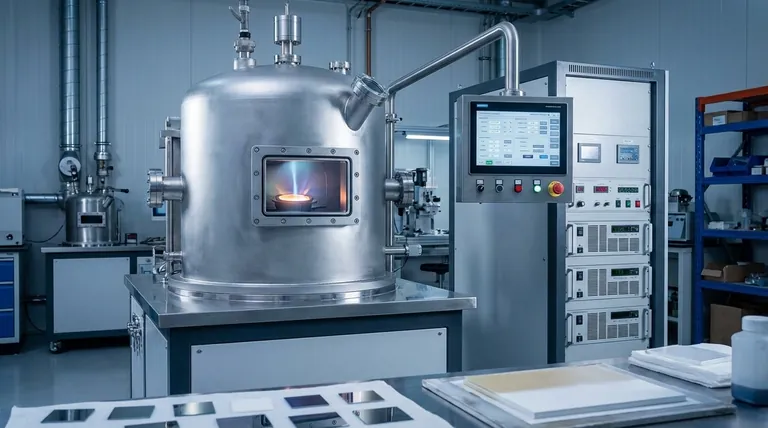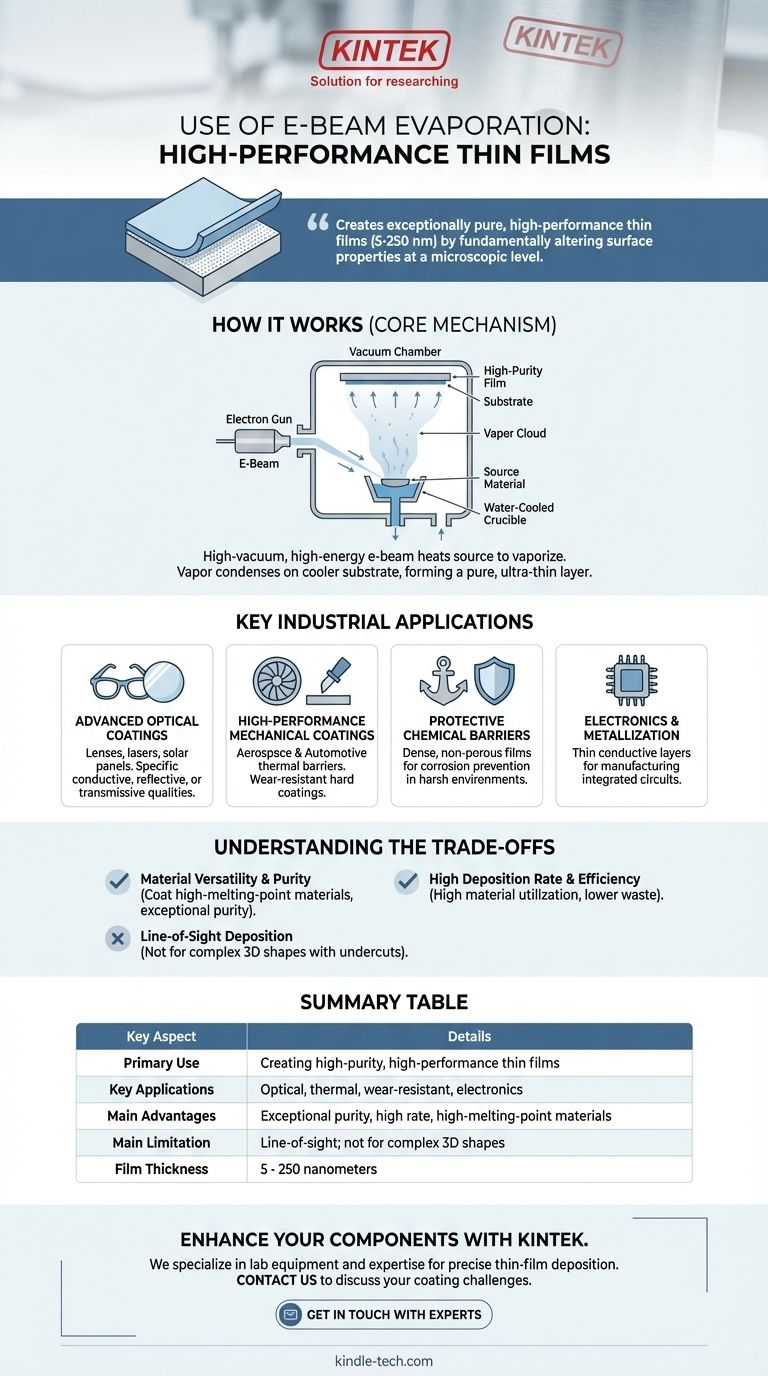In essence, electron beam (e-beam) evaporation is used to create exceptionally pure, high-performance thin films on a material's surface. This process is critical for applications that demand specific properties like high-temperature tolerance, chemical and wear resistance, or precise optical characteristics. It is a foundational technology in industries ranging from aerospace and automotive to advanced electronics and optics.
The core purpose of e-beam evaporation is not simply to coat a surface, but to fundamentally alter its properties at a microscopic level. It allows engineers to deposit a highly pure, ultra-thin layer of material to give a component new capabilities it wouldn't otherwise possess.

How E-Beam Evaporation Works
The Core Mechanism
The process takes place inside a high-vacuum chamber. A high-energy electron beam is precisely focused on a source material, such as a metal or ceramic, held in a water-cooled crucible.
This intense, targeted energy heats the source material until it melts and evaporates, turning into a vapor.
The vapor then travels upward through the vacuum and condenses onto a cooler substrate (the object being coated) positioned above, forming a thin, solid film.
The Result: A High-Purity Film
This method produces a very high-purity coating, typically between 5 and 250 nanometers thick. The direct heating from the electron beam ensures only the source material is vaporized, minimizing contamination.
Because the film is so thin, it enhances the substrate's surface properties without affecting its overall dimensional accuracy, which is critical for precision components.
Key Industrial Applications
Advanced Optical Coatings
E-beam evaporation is a dominant technology for manufacturing optical thin films. It is used to give glass and other materials specific conductive, reflective, or transmissive qualities.
Key applications include anti-reflective coatings on eyeglasses and camera lenses, reflective films for laser optics, and coatings for architectural glass and solar panels.
High-Performance Mechanical Coatings
In the aerospace and automotive industries, components must withstand extreme conditions. E-beam evaporation is used to apply thermal barrier coatings that resist high temperatures.
It is also used to create durable, hard coatings on cutting tools and engine parts, dramatically increasing their wear resistance and lifespan.
Protective Chemical Barriers
For components exposed to harsh environments, a protective layer is essential.
E-beam evaporation can deposit a dense, non-porous film that acts as a chemical barrier. This is used on marine fittings and industrial components to prevent corrosion.
Electronics and Metallization
The process is also used in the electronics industry for metallization, where a thin layer of conductive material is deposited onto a substrate. This is a key step in manufacturing integrated circuits and other electronic components.
Understanding the Trade-offs
Advantage: Material Versatility and Purity
One of the greatest strengths of e-beam evaporation is its ability to deposit a wide variety of materials, including those with very high melting points like titanium or ceramics. The purity of the final film is exceptional.
Advantage: High Deposition Rate and Efficiency
Compared to other deposition methods, e-beam evaporation often achieves higher deposition rates. It also offers high material utilization efficiency, which reduces waste and lowers costs, especially in high-volume production.
Limitation: Line-of-Sight Deposition
The evaporated material travels in a straight line from the source to the substrate. This "line-of-sight" characteristic means it is excellent for coating flat surfaces but is not suitable for uniformly coating complex, three-dimensional shapes with undercuts or hidden surfaces.
Making the Right Choice for Your Goal
- If your primary focus is optical performance: E-beam is ideal for creating multi-layer films with the precise reflective and transmissive properties required for lenses, filters, and solar cells.
- If your primary focus is material purity and high-temperature resistance: This process is a superior choice for aerospace and advanced components where contamination is unacceptable and thermal management is key.
- If your primary focus is a wear-resistant hard coating: E-beam provides a highly efficient method for creating durable surfaces on cutting tools and mechanical parts, extending their operational life.
Ultimately, e-beam evaporation empowers engineers to fundamentally enhance a material's surface, turning standard components into high-performance assets.
Summary Table:
| Key Aspect | Details |
|---|---|
| Primary Use | Creating high-purity, high-performance thin films |
| Key Applications | Optical coatings, thermal barriers, wear-resistant layers, electronics metallization |
| Main Advantages | Exceptional purity, high deposition rate, ability to coat high-melting-point materials |
| Main Limitation | Line-of-sight process; not ideal for complex 3D shapes with undercuts |
| Typical Film Thickness | 5 - 250 nanometers |
Ready to enhance your components with high-purity thin films?
E-beam evaporation is a powerful solution for applications demanding exceptional material purity, high-temperature resistance, and precise optical performance. Whether you're developing advanced optics, durable aerospace components, or sophisticated electronics, the right coating process is critical to your success.
At KINTEK, we specialize in providing the lab equipment and expertise needed for precise thin-film deposition. Our solutions help you achieve the material properties required for breakthrough innovations.
Contact us today to discuss your specific coating challenges and discover how we can support your R&D and production goals. Let's turn your components into high-performance assets.
Get in touch with our experts now!
Visual Guide

Related Products
- HFCVD Machine System Equipment for Drawing Die Nano-Diamond Coating
- 915MHz MPCVD Diamond Machine Microwave Plasma Chemical Vapor Deposition System Reactor
- Laboratory CVD Boron Doped Diamond Materials
- CF KF Flange Vacuum Electrode Feedthrough Lead Sealing Assembly for Vacuum Systems
- Vacuum Hot Press Furnace Machine for Lamination and Heating
People Also Ask
- What is direct current DC magnetron sputtering? A Guide to High-Quality Thin Film Deposition
- How do CVD diamonds grow? A Step-by-Step Guide to Lab-Grown Diamond Creation
- How do you calculate coating coverage? A Practical Guide to Accurate Material Estimation
- How is diamond coating made? A Guide to CVD and PVD Methods
- What is the hot filament chemical vapour deposition of diamond? A Guide to Synthetic Diamond Coating



















